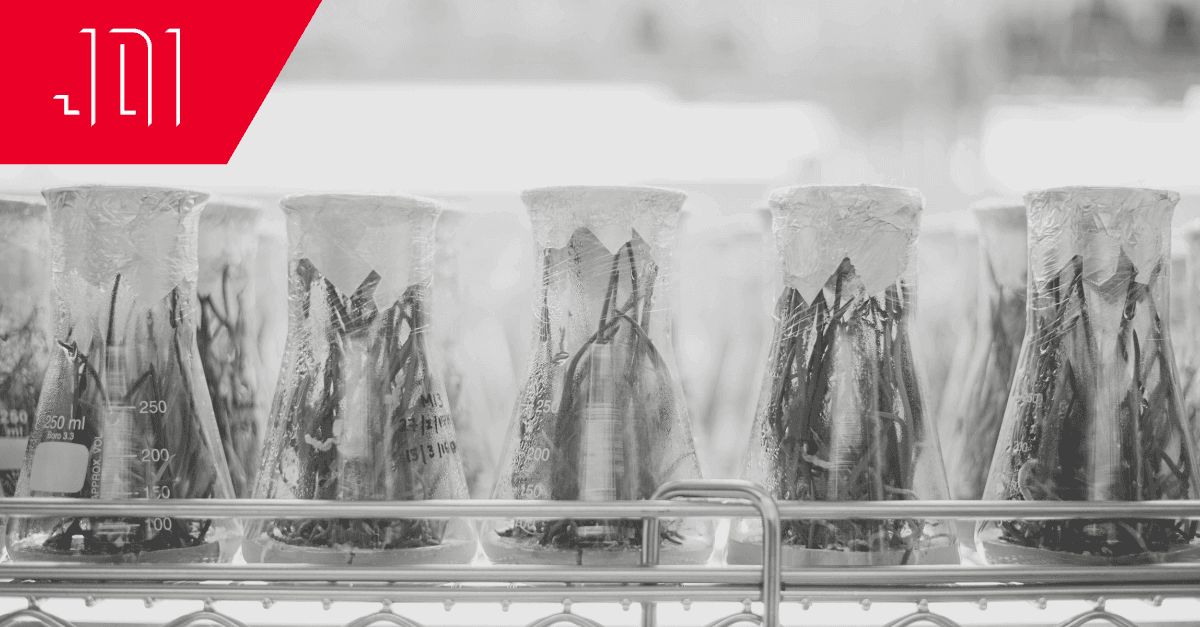Climate Biotech 101: The Basics of Biotechnology’s Best-Kept Secret

Climate change is one of the most pressing challenges of our time and innovative solutions are desperately needed now more than ever. Enter climate biotechnology: a cutting-edge field that holds immense promise yet remains largely overlooked.
At JDI, collaborating with innovators in emerging science and technology positions our consultancy to tell stories of the technologies and products that exist on the edge of what’s possible. It’s been our privilege to partner with clients, like the climate biotechnology experts at Homeworld Collective, who provide us with an insider's look at this emerging field.
By the end of this piece, you'll grasp the basics of climate biotechnology and be prepared to join a topic that’s vital to our collective future and demands to be a part of more conversations. With that let’s dive in and discover how biotechnology could help us turn the tide on climate change, uncovering the basics of biotechnology’s best-kept secret.
What Is Climate Biotechnology?
Climate biotechnology is a field that involves the use of biological systems, organisms, or derivatives to develop technologies and products that help mitigate or adapt to climate change. It encompasses multiple other fields, including, but not limited to, genetic engineering, synthetic biology, and bioengineering to create sustainable solutions.
The impact of these solutions is extensive, taking shape in the form of reduced greenhouse gas emissions, the creation of innovative materials, restoration of wetlands and forests, enhanced waste management processes, the development of sustainable fuels, and the emergence of agricultural practices hinged on engineered crop resilience, productivity, and reducing the need for harmful synthetic chemicals. In harnessing the power of natural processes to address environmental challenges, climate biotechnology ultimately aims to reduce our human footprint and alleviate the pressures of climate change on our planet.
In recent years, we’ve seen an uptick in the consequences of climate change, such as wildfires, global food shortages, floods, tornadoes, hurricanes, heat waves, and more. A safe, healthy, and sustainable future for us all is hanging in a fragile balance and the need for innovative solutions to mitigate climate change is increasingly urgent. Climate biotechnology offers a range of solutions, and as the field is expected to exponentially grow in the coming years, we can expect unprecedented products, tools, processes, technologies, and systems.
Global Applications and Current Challenges
The applications of climate biotechnology span global sustainability efforts, ecosystems, and health challenges. Below, you can find a high-level breakdown of some of the most anticipated applications of climate biotechnology:
Sustainability Applications
Enhancing carbon capture techniques to reduce atmospheric CO2 levels through genetic modification.
Genetically Modified Organisms (GMOs:) Genetically engineered microorganisms can capture CO2 from the atmosphere and convert it into useful byproducts like biofuels or biodegradable plastics.
Example: A group of scientists with Argonne National Laboratory and the University of Chicago, Northern Illinois University, and Valparaiso University, developed a strain of bacteria that converts CO2 into acetate, which can be used as a building block for various chemicals. Leveraging a different approach for a similar outcome, Living Carbon, a Bay Area biotech startup, is genetically enhancing the ability of trees to capture and store carbon dioxide – using plants to rebalance the planet's carbon cycle.
Developing bio-based renewable energy sources to replace fossil fuels.
Example: Looking to alternative fuels, algae biofuels offer a promising path forward. Algae produces oil that can be refined into sustainable alternatives to traditional fossil fuels. Multinational oil and gas giant, ExxonMobil, recently partnered with Synthetic Genomics to create algae strains that produce high yields of biofuels, potentially revolutionizing the energy sector.
Health Applications
Creating crops that are resilient to climate change, ensuring food security.
Example: As one of the three leading crops in the world, rice provides nutrition, employment, and livelihoods for countless people. With climbing temperatures and rising floodwaters destroying harvests and depleting yields, global rice production is expected to shrink. Recently, the International Rice Research Institute has developed rice varieties that can withstand flooding, drought, and salinity, thus ensuring stable rice production amidst changing climates.
Developing biotechnologies to clean polluted environments, reducing health hazards.
Example: Bioremediation, a process that uses plants and microbes to clean up contaminated soil and water, is a prime example of leveraging biotechnology to create cleaner and safer environments. Phytoremediation projects, an extension of bioremediation, utilize plants, like poplar trees, to absorb heavy metals from polluted soils and remove toxic elements from industrial sites.
New Material Applications
Climate biotechnology is making strides in developing biodegradable materials and plastics to reduce plastic pollution and waste.
Example: Companies like NatureWorks are using technology to turn greenhouse gasses into PLA (polylactic acid) bioplastics derived from corn starch. Marketed under the brand Ingeo, NatureWorks, uses plants like corn, cassava, sugar cane, or beets to capture and sequester CO2, transforming it into long-chain sugar molecules that are then milled to extract starch.
Ecosystems Applications
In addition to bioremediation, reforestation is a major pillar of climate biotechnology. Using biotechnology to restore and enhance wetlands and forests, which act as critical carbon sinks, is an area of focus within the field.
Example: Mycorrhizal fungi form symbiotic relationships with the roots of most plant species, including many trees. These fungi enhance the ability of plants to absorb water and nutrients, particularly phosphorus, which is essential for plant growth. In places like the Amazon, where rates of deforestation are expected to leave 27% of the forest without trees by 2030, mycorrhizal fungi inoculation is being used to support reforestation efforts by increasing seedling survival rates, accelerating tree growth and development, improving soil health, etc.
Despite its potential, climate biotechnology faces several significant challenges. One of the primary obstacles is the lack of funding and resource limitations. Of 150,000+ National Science Foundation grants and over 175,000 DoE-funded publications analyzed last year, only .1% of NSF funding and 1% of DoE publications were for protein engineering in the context of climate.
While initiatives like Homeworld Collective's Garden Grants are attempting to address this issue, the field still struggles to attract the level of investment seen in medical and pharmaceutical biotechnology ventures.
Public perception and lack of awareness also pose challenges. Climate biotechnology is often overshadowed by medical and pharmaceutical ventures in the biotechnology sector, making it difficult to garner public support and understanding of its potential impact on climate change mitigation.
Technical and scientific hurdles present a further set of challenges, as bringing ideas to life in this field is quite difficult without clearly defined career paths, resources, and opportunities, in addition to a limited number of collaborators. Unlike established biotechnology sectors, climate biotechnology lacks the luxury of extensive trial and error due to funding constraints and the urgency of addressing climate change.
These challenges underscore the need for increased support, awareness, and collaboration in the field of climate biotechnology to fully realize its potential and unleash positive impacts on our planet and all who inhabit it.
Who’s Leading The Charge and Where Is The Field Headed?
Nonprofits and Companies Focused on Climate Biotechnology
Homeworld Collective: In addition to developing biotechnologies that address climate change, Homeworld is a non-profit that focuses on providing grants and spearheading projects ranging from carbon sequestration to creating resilient ecosystems.
Pivot Bio: Pivot develops microbial solutions to improve crop yields and reduce dependency on synthetic fertilizers.
Caribou Bioscience: Caribou utilizes CRISPR technology for genome editing, aiming to create genetically modified organisms that can thrive under changing environmental conditions.
Novozymes: Novozymes specializes in industrial enzymes and microbes that can enhance agricultural productivity and environmental sustainability.
Indigo Agriculture: Indigo focuses on improving plant health and productivity through microbiome-enhancing technologies.
Synthetic Genomics (now Viridos:) Synthetic Genoics was a biotechnology company dedicated to advancing synthetic biology to produce biofuels and renewable chemicals. They recently rebranded to Viridos, a biotechnology company using photosynthesis to develop products like renewable algae biofuel.
Emerging Trends and Expected Challenges
The following trends and innovations will likely result in significant breakthroughs, however, said breakthroughs are hinged on increased collaboration between biotechnology firms, research institutions, and policymakers to create supportive frameworks for sustainable innovation:
CRISPR and Gene Editing: Advancements in precise genetic modifications are expected to further the development of and variety of resilient crops and microorganisms for environmental remediation.
Synthetic Biology: Continued development of synthetic organisms is poised to provide us with more organisms designed to efficiently perform specific functions, such as breaking down pollutants or capturing CO2.
Microbiome Engineering: Microbial communities are an avenue we’re expecting to explore to enhance soil health, crop productivity, and carbon sequestration.
Expected Challenges and The Future of Climate Biotechnology
Funding and Resource Limitations
- Continued insufficient funding compared to other fields like renewable energy and information technology.
- Expected difficulty in attracting future investments due to the perceived high risk and long development timelines.
Regulatory and Ethical Considerations
- Regulatory landscapes vary by region. With no one-size-fits-all model and a lack of policy support across the board, regulations on climate biotechnology are expected to be difficult to establish and standardize going forward.
- Ethical concerns regarding genetic modification and synthetic biology, including potential ecological impacts and biosecurity risks, are expected to challenge the growth and development of the field.
Scalability
Climate biotechnology is not about finding a band-aid to climate change. Ensuring that solutions originating in the field are not quick fixes, but long-term solutions that are scalable and replicable for generations to come is crucial.
Mitigating Fear and/or Mistrust Around Biotechnology
Addressing misconceptions and skepticism about the safety and ethics of biotechnology is expected to become more of a challenge as innovations emerge. Doing so will require the field to harbor a humanistic approach, shining a light on the people behind the science and the stories that are driving it forward to diminish the skepticism and mistrust that is often tethered to science, technology, and new innovations.
Climate Biotechnology, A Beacon of Hope
Propelled forward by hope for a better future and healthier planet, climate biotechnology has the capacity to right some of the missteps of the past. From genetically modified crops to biofuels, the applications of climate biotechnology are vast and promising – showing us how technology, science, and nature can work in harmony to forge a better understanding of our planet and a better future.
Further Resources
- 12 predictions for the future of technology (TED Tech Podcast, Podcast Episode)
- Biotechnology and Climate Change (USDA)
- What Is Climate Biotech? (Article, Homeworld Collective)
- Work on Climate X Homeworld Collective - Work in Climate Biotech (Work on Climate, Video)
- The problem with food and climate — and how to fix it (TED, Video)



